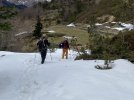Flog
Pilgrim
- Time of past OR future Camino
- 2055
I wrote this long-winded post to address some of the recent concerns, comments and questions regarding this route, and I hope some might find it useful. I flew from Dublin to Lourdes on the 18th of April, took the train to Pau and started walking from there. A few days on the Camino Arles through Lescar, Oloron, Sarrance and Urdos, before the climb up to Somport and the start of the Aragonês..
The washed away section of the path between Accous and Borce
Just beyond Cette-Eygon, where a small section of the path gave way and slid down into the river below, a new ledge has been cut, about ten metres long and about three metres above the path, making this section passable with care. This looks to have been done very recently, as it hasn't compacted much from foot traffic yet. There is warning sign just before it, and you can divert onto the road if necessary.
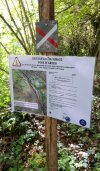
The railway tunnel before Urdos
A sign directs you off the road up some temporary steps to the entrance of the tunnel. There's a mention somewhere, of it being five hundred metres long.. or something. But it feels more like a kilometre or more, and after the first hundred metres as you round the curve, you're in total darkness for a good twenty minutes, the only sounds are the crunching and tripping of your boots along the railway ballast, and of water dripping in some places and gushing in others. My phone torch was just about adequate to see my feet in front of me, nothing more. I walked through it alone and have to admit, I found it a little unnerving. Me, a grown man who spent much of his childhood getting up to all sorts of divilment, exploring caves and railway tunnels and everything.. even though there hasn't been a train through here in more than fifty years. As you exit the tunnel, you have to continue on an elevated, rusted iron bridge for another two hundred metres or so. If any of this is a concern for you, try to pair up with another pilgrim.
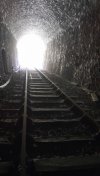
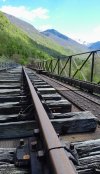
Up and over the Somport Pass
A friend joined me at Urdos, and we were four pilgrims altogether, leaving Gîte Le Compostelle at 8am. As it was snowing and below freezing, we opted to walk up by the N134, which happily was devoid of both traffic and roadworks. It was the only choice really, given that visibility was so poor, and the path would have been impossible. Still, it was beautiful! We found ourselves up at Somport less than four hours later and continued down into Canfranc Estación by the road. Again, the path wouldn't have been an option with the uneven ground hidden from view under a light blanket of snow. I've walked up and over the pass before, in fine weather, and always by the path. I was surprised, especially given the conditions, how much easier it is on the road, and I suspect the views, had we had any, would have been just as good. In conclusion, don't rule out the road, whatever the weather.. we saw a total of about ten cars in six hours or so. Halfway down from the pass, it stopped snowing and the sun appeared.
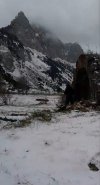
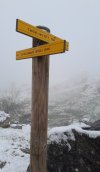
Canfranc Estación Hotel
Don't expect to be welcomed with open arms here as a pilgrim, don't even think of coming in for a coffee, unless you're a paying guest. We went in just for a quick snoop, two of us. The porter, trundling a polished brass trolley, loaded with suitcases past us, looked down at our walking shoes in disgust, and I returned the compliment.... yep, he won the shiny shoes contest! The last time I entered the main lobby was in the Spring of 2019 when the station was a damp, dark and derelict shell, full of graffiti, peeling plaster and broken tiles, though the roof had been replaced. Still, it conjured up majestic images, evocative of it's past splendour. What they've done with it is astonishing, breathtaking even... but the whole thing is a bit overcooked, in my view. I liked the mysterious and sinister atmosphere of it before, when it had an edge to it...
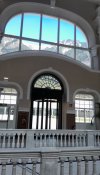
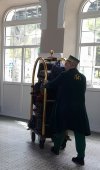
The bridge over Embalse de Canfranc
Some temporary wooden steps have been put in place recently, making it possible to safely cross below the dam, but with care. We found it easier with two of us, so we could pass the packs and poles to each other. There's nothing to say this temporary arrangement won't get washed away in another storm surge, or sudden opening of one of the sluice gates, but it looks good for now and it'll get you over onto the lovely wooded trail, that runs all the way down into the pueblo.
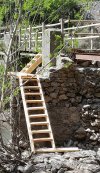
Albergue Elías Valiña, Canfranc
After a delayed start this year due to essential remedial works, the lovely albergue in Canfranc is open again. We were made so welcome by the current hospis, Pedro and Roser and had a great evening with them. Not only did they entertain and cook for five of us pilgrims, Pedro also insisted on driving my friend back up to the pass early the next morning to take photos! (She had been disappointed at not getting any good ones the day before, because of the poor visibility.) It's a donativo, please remember to give generously!
Los Monasterios San Juan de la Peña
It was a shortish day from Jaca to Santa Cilia and I arrived way too early and still full of energy. So what to do? For fun.. and for research, I decided to ramble up towards the monasteries, to see how long it would take me from Santa Cilia, up and back. I dumped my pack with Victor at the albergue and let him know my plan, before grabbing my stick and walking the two kilometres back along the N240 before taking the minor road up, first to Santa Cruz, then on up to the old monastery. It was cool and dry. It's about fourteen kilometres up this way and there was almost no traffic. The road is steep with sharp switchbacks, but fairly consistent and it took me a full three hours to get to the old monastery. The lady at the little kiosk was a bit perplexed that I only wanted a sello, until I explained that I'd already been to see both monasteries before.. she gave me three different sellos for my trouble! Coming back down, (I didn't venture up to the new monastery this time) I took the path. It started to rain and I got soaked, but before I got down to Santa Cruz, the sun had come out and I was almost dry again by the time I got back to Santa Cilia. The path down is a good bit shorter than the road.. about eleven kilometres. True, it's a lot more difficult, especially in the wet and it took all my concentration to avoid tripping and slipping with the loose boulders and everything, particularly along a kilometer stretch near the top, but it's as I remembered it, really not all that bad.. and it's a whole lot easier without a pack! The way has also been very recently painted with new GR route symbols every hundred metres or so.. you might trip and hurt yourself if you're not careful, sure.. but you definitely won't lose your way! Coming back down took about the same amount of time, perhaps a little less. So altogether, it was a nine hour day of around forty two kilometers. I'm not suggesting it's for everyone by any means, but I found it to be ok and within my limits.
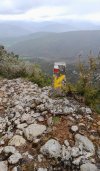
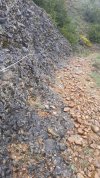
In conclusion, the Aragonês hasn't changed a whole lot in the past five years. Way marking, ATMs and water availability are a bit thin on the ground, especially in the latter stages, but just plan your days and carry water and snacks. And pilgrims are still thin on the ground, too. There are some long and lonely days, but if you want to walk in solitude for a week in beautiful nature, and stay in some fantastic places, you could do worse.
I'm further along now. After tomorrow I'll reach Puenta la Reina and from there, I may continue for a few days along the Frances, or if it feels too busy, I might take a bus to León and head across the San Salvador to Oviedo. I have a volunteering stint in Güemes beginning on the 6th of May so I have some days, and days are good things to have...
.
The washed away section of the path between Accous and Borce
Just beyond Cette-Eygon, where a small section of the path gave way and slid down into the river below, a new ledge has been cut, about ten metres long and about three metres above the path, making this section passable with care. This looks to have been done very recently, as it hasn't compacted much from foot traffic yet. There is warning sign just before it, and you can divert onto the road if necessary.

The railway tunnel before Urdos
A sign directs you off the road up some temporary steps to the entrance of the tunnel. There's a mention somewhere, of it being five hundred metres long.. or something. But it feels more like a kilometre or more, and after the first hundred metres as you round the curve, you're in total darkness for a good twenty minutes, the only sounds are the crunching and tripping of your boots along the railway ballast, and of water dripping in some places and gushing in others. My phone torch was just about adequate to see my feet in front of me, nothing more. I walked through it alone and have to admit, I found it a little unnerving. Me, a grown man who spent much of his childhood getting up to all sorts of divilment, exploring caves and railway tunnels and everything.. even though there hasn't been a train through here in more than fifty years. As you exit the tunnel, you have to continue on an elevated, rusted iron bridge for another two hundred metres or so. If any of this is a concern for you, try to pair up with another pilgrim.


Up and over the Somport Pass
A friend joined me at Urdos, and we were four pilgrims altogether, leaving Gîte Le Compostelle at 8am. As it was snowing and below freezing, we opted to walk up by the N134, which happily was devoid of both traffic and roadworks. It was the only choice really, given that visibility was so poor, and the path would have been impossible. Still, it was beautiful! We found ourselves up at Somport less than four hours later and continued down into Canfranc Estación by the road. Again, the path wouldn't have been an option with the uneven ground hidden from view under a light blanket of snow. I've walked up and over the pass before, in fine weather, and always by the path. I was surprised, especially given the conditions, how much easier it is on the road, and I suspect the views, had we had any, would have been just as good. In conclusion, don't rule out the road, whatever the weather.. we saw a total of about ten cars in six hours or so. Halfway down from the pass, it stopped snowing and the sun appeared.


Canfranc Estación Hotel
Don't expect to be welcomed with open arms here as a pilgrim, don't even think of coming in for a coffee, unless you're a paying guest. We went in just for a quick snoop, two of us. The porter, trundling a polished brass trolley, loaded with suitcases past us, looked down at our walking shoes in disgust, and I returned the compliment.... yep, he won the shiny shoes contest! The last time I entered the main lobby was in the Spring of 2019 when the station was a damp, dark and derelict shell, full of graffiti, peeling plaster and broken tiles, though the roof had been replaced. Still, it conjured up majestic images, evocative of it's past splendour. What they've done with it is astonishing, breathtaking even... but the whole thing is a bit overcooked, in my view. I liked the mysterious and sinister atmosphere of it before, when it had an edge to it...


The bridge over Embalse de Canfranc
Some temporary wooden steps have been put in place recently, making it possible to safely cross below the dam, but with care. We found it easier with two of us, so we could pass the packs and poles to each other. There's nothing to say this temporary arrangement won't get washed away in another storm surge, or sudden opening of one of the sluice gates, but it looks good for now and it'll get you over onto the lovely wooded trail, that runs all the way down into the pueblo.

Albergue Elías Valiña, Canfranc
After a delayed start this year due to essential remedial works, the lovely albergue in Canfranc is open again. We were made so welcome by the current hospis, Pedro and Roser and had a great evening with them. Not only did they entertain and cook for five of us pilgrims, Pedro also insisted on driving my friend back up to the pass early the next morning to take photos! (She had been disappointed at not getting any good ones the day before, because of the poor visibility.) It's a donativo, please remember to give generously!
Los Monasterios San Juan de la Peña
It was a shortish day from Jaca to Santa Cilia and I arrived way too early and still full of energy. So what to do? For fun.. and for research, I decided to ramble up towards the monasteries, to see how long it would take me from Santa Cilia, up and back. I dumped my pack with Victor at the albergue and let him know my plan, before grabbing my stick and walking the two kilometres back along the N240 before taking the minor road up, first to Santa Cruz, then on up to the old monastery. It was cool and dry. It's about fourteen kilometres up this way and there was almost no traffic. The road is steep with sharp switchbacks, but fairly consistent and it took me a full three hours to get to the old monastery. The lady at the little kiosk was a bit perplexed that I only wanted a sello, until I explained that I'd already been to see both monasteries before.. she gave me three different sellos for my trouble! Coming back down, (I didn't venture up to the new monastery this time) I took the path. It started to rain and I got soaked, but before I got down to Santa Cruz, the sun had come out and I was almost dry again by the time I got back to Santa Cilia. The path down is a good bit shorter than the road.. about eleven kilometres. True, it's a lot more difficult, especially in the wet and it took all my concentration to avoid tripping and slipping with the loose boulders and everything, particularly along a kilometer stretch near the top, but it's as I remembered it, really not all that bad.. and it's a whole lot easier without a pack! The way has also been very recently painted with new GR route symbols every hundred metres or so.. you might trip and hurt yourself if you're not careful, sure.. but you definitely won't lose your way! Coming back down took about the same amount of time, perhaps a little less. So altogether, it was a nine hour day of around forty two kilometers. I'm not suggesting it's for everyone by any means, but I found it to be ok and within my limits.


In conclusion, the Aragonês hasn't changed a whole lot in the past five years. Way marking, ATMs and water availability are a bit thin on the ground, especially in the latter stages, but just plan your days and carry water and snacks. And pilgrims are still thin on the ground, too. There are some long and lonely days, but if you want to walk in solitude for a week in beautiful nature, and stay in some fantastic places, you could do worse.
I'm further along now. After tomorrow I'll reach Puenta la Reina and from there, I may continue for a few days along the Frances, or if it feels too busy, I might take a bus to León and head across the San Salvador to Oviedo. I have a volunteering stint in Güemes beginning on the 6th of May so I have some days, and days are good things to have...
.
Last edited:






